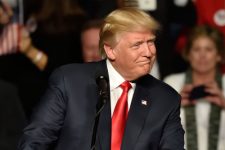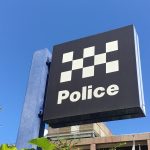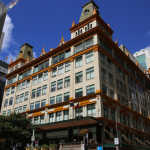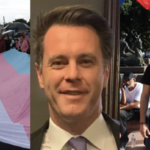Trump Fans the Flames of Hate

Joe Arpaio is the former sheriff of Maricopa County in Arizona. Under his 24-year tenure as the head of law enforcement, Arpaio was renowned for his sweeps to round up illegal immigrants, as well as for opening Tent City: an outdoor prison that he referred to as a “concentration camp.”
The sweeps targeted Latino neighbourhoods and involved traffic stops and workplace raids. In 2011, a civil rights case was brought against Arpaio and a federal judge ordered him to stop detaining Latino motorists solely on suspicion that they were in the country illegally.
However, Arpaio continued with his racial profiling practices, and last month he was found in contempt of court.
The old boy’s club
US president Donald Trump asked attorney general Jeff Sessions to drop the case against Arpaio, who was facing prison time. But Mr Sessions told the president that would be inappropriate. So Trump simply pardoned the former sheriff, who has a long list of atrocities against his name.
The president announced his decision in a tweet last Sunday.The move comes as no surprise. It’s just a continuation of the racist ideology that has marked Trump’s short term as president, and his rantings while he was running for office.
Indeed, Arpaio was a strong supporter of Trump’s crusade to prove Barack Obama was born in Kenya and therefore ineligible to be head of state. Trump abandoned this muckraking exercise in September last year and admitted the then president was born in the US.
The trouble in Charlottesville
Under Trump’s tutelage, white supremacist sentiment has been left unchecked and is on the rise. Recent events in Charlottesville make this plain to see.
On the night of August 11, white supremacists and neo-Nazis descended upon the campus of the University of Virginia. In scenes reminiscent of Ku Klux Klan rallies of early last century, protesters gathered at the university carrying tiki torches and chanting “you will not replace us” and “white lives matter.”
The group had gathered prior to the Unite the Right rally planned for the following day. It was set to be one of the largest white supremacist events in recent US history. The rally was to demonstrate against the removal of a statue of Confederate icon General Robert E Lee.
The statue is one amongst many earmarked for removal that celebrate those that led the southern states during the American civil war in the fight to preserve the institution of slavery.
The statues were not built immediately after the war, but during two subsequent periods. The first was around 1900, when the Jim Crow laws that disenfranchised African Americans were enacted. And the second was during the rise of the Civil Rights Movement in the 1950s.
Countering prejudice
On August 12, as the white supremacist protesters began to gather ahead of the rally, anti-racist counter-demonstrators showed up on the streets. And as the two groups began to clash, the City of Charlottesville called a state of emergency.
During the afternoon, right-wing protester James Alex Fields Jr allegedly rammed his car into a group of anti-racist demonstrators, killing 32-year-old civil rights activist Heather Heyer and injuring at least nineteen other people.
Some of the counter-demonstrators were made up of the antifa: an umbrella group of anarchists and anti-fascists, who were reported to have strategically provoked the white supremacists with the aim of having the Unite the Right rally cancelled. And they succeeded.
In collusion
The US president’s response to the violence of the protests was widely condemned, as he drew a moral equivalency between the far-right instigators and the counter-demonstrators, and held both groups equally to blame.
Trump defended those on the far-right stating that not of them “were neo-Nazis” and “not all those people were white supremacists.” He also said “the press has treated them absolutely unfairly.”
The president said that many of the far-right demonstrators were only there to protest the removal of the statue. And then he questioned whether statues of George Washington and Thomas Jefferson were going to be the next to go.
In the wake of Charlottesville, thousands turned up to protest Trump at his first major rally since the incident. Held in Phoenix, Arizona on August 22, the rally descended into chaos as skirmishes broke out between anti-Trump protesters and the president’s supporters.
Police responded by firing tear gas and stun grenades into the crowd protesting the president. And six members of the Redneck Revolt, an anti-fascist group, turned up to the rally carrying military-style rifles to protect the protestors. Laws in Arizona allow people to openly carry weapons.
A copycat attack
And in an incident reminiscent of Charlottesville, a car ploughed into a group gathered for a vigil in St Louis for a transgender woman, who was recently shot dead by police officers. Those hit by the white driver on August 23 only suffered minor injuries.
Kiwi Herring was shot by police after allegedly stabbing her neighbour and then slashing the arm of an officer, who was attending the scene. It’s been claimed 30-year-old Herring was under continual harassment from her neighbour.
The Trump administration has also taken aim at the nation’s transgender community and set about revoking recently won gains. In March, an Obama administration decree was withdrawn that directed schools to allow transgender students access to bathrooms matching their gender identity.
And last Friday, Trump sent a memo to US defence secretary Jim Mattis officially banning transgender people from the military and halting the use of government funding for gender-reassignment surgery. Again, reversing policies instigated by Obama.
Administering racial divides
Scenes like Charlottesville are what many feared when Trump won the election on November 8 last year. His campaign was racially-fuelled with promises like the proposal to build a wall along the US-Mexico border, which was designed to keep out “criminals” and “rapists.”
One of Trump’s first moves in office was to issue an executive order for a temporary Muslim travel ban to the US. Initially blocked by lower court rulings, the US Supreme Court allowed a revised version of the ban on people from six mainly Muslim countries and all refugees to proceed in June.
White nationalist terrorism
The travel ban was implemented due to the threat of Islamic terrorists, according to the president. However, Trump might want to consider the terrorist threat being posed by white nationalists in his own country.
On June 22, a joint report was released by the Investigative Fund at the Nation Institute and Reveal from the Centre for Investigative Reporting that found over the past nine years, right-wing extremists have planned or carried out almost twice as many terrorist attacks, than Islamic extremists.
Of the 115 right-wing incidents on US soil, the police had prevented only 35 percent of them. This is compared with the 63 Islamic cases, where police foiled 76 percent of the attacks.
With a racially-charged president less than a year into his term in office, it seems the white nationalist terrorist threat in the US has the potential to grow. And the age of Trump might be marked by a deepening of racial divisions instigated yet again by the white majority.







